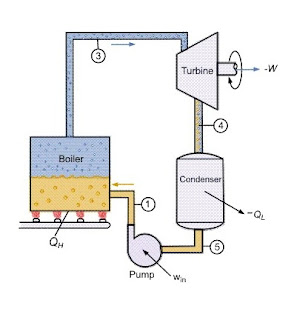The Rankine cycle is the fundamental operating cycle of all power plants where an operating fluid is continuously evaporated and condensed.
For each process in the vapour power cycle, it is possible to assume a hypothetical or ideal process which represents the basic intended operation and involves no extraneous effects.
For the steam boiler, this would be a reversible constant pressure heating process of water to form steam.
For the turbine, the ideal process would be a reversible adiabatic expansion of steam.
For the condenser, it would be a reversible constant pressure heat rejection as the steam condenses until it becomes saturated liquid.
For the pump, the ideal process would be the reversible adiabatic compression of this liquid ending at the initial pressure.
When all these four processes are ideal, the cycle is an ideal cycle, called the Rankine cycle.
Efficiency is the ratio between energy output to energy input. Here work done is energy output and energy input is heat addition.
Net work is done = Work done in turbine + Work done in pump
Net heat transfer = Heat produced in boiler + Heat rejected in the condenser
What is the Rankine cycle?
For each process in the vapour power cycle, it is possible to assume a hypothetical or ideal process which represents the basic intended operation and involves no extraneous effects.
For the steam boiler, this would be a reversible constant pressure heating process of water to form steam.
For the turbine, the ideal process would be a reversible adiabatic expansion of steam.
For the condenser, it would be a reversible constant pressure heat rejection as the steam condenses until it becomes saturated liquid.
For the pump, the ideal process would be the reversible adiabatic compression of this liquid ending at the initial pressure.
When all these four processes are ideal, the cycle is an ideal cycle, called the Rankine cycle.
The efficiency of the Rankine cycle :
Efficiency is the ratio between energy output to energy input. Here work done is energy output and energy input is heat addition.
Net work is done = Work done in turbine + Work done in pump
Net heat transfer = Heat produced in boiler + Heat rejected in the condenser
ŋ =
WT - WP / QS
